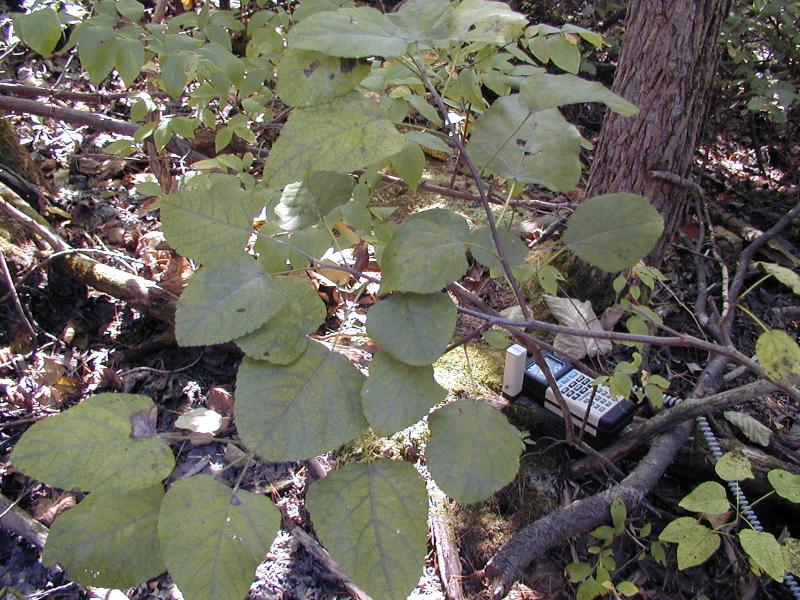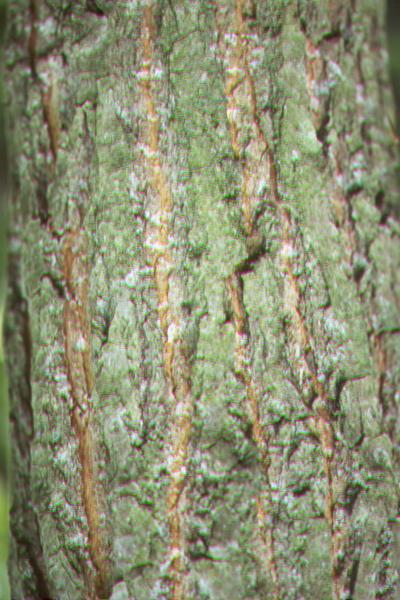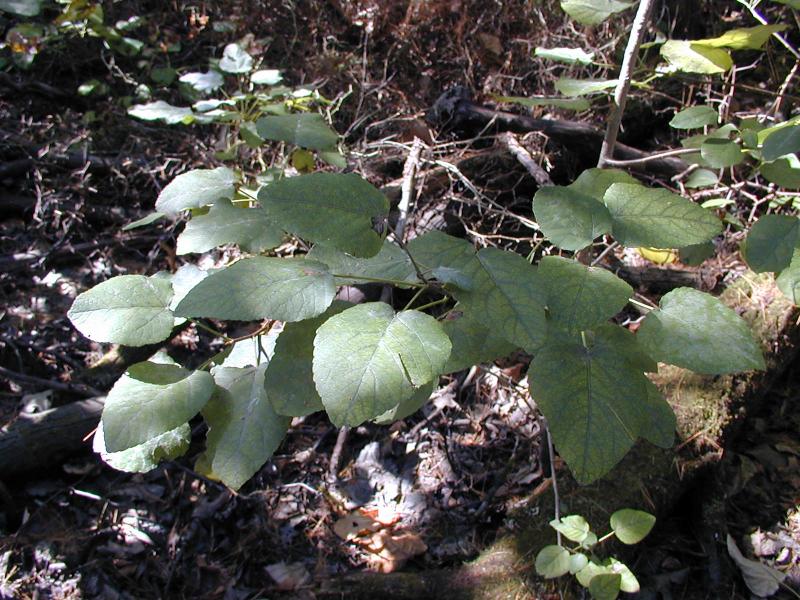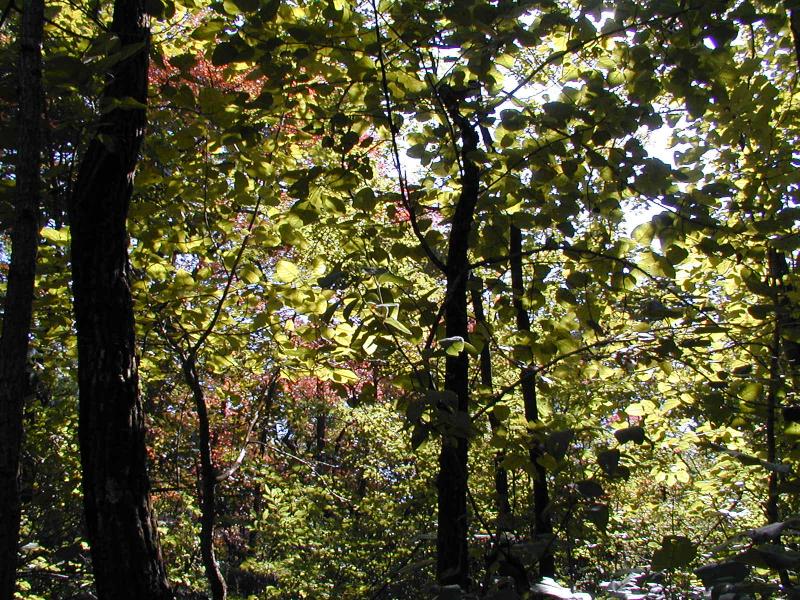Swamp Cottonwood
Populus heterophylla L.
- Class
- Dicotyledoneae (Dicots)
- Family
- Salicaceae (Willow Family)
- State Protection
- Threatened
Listed as Threatened by New York State: likely to become Endangered in the foreseeable future. For animals, taking, importation, transportation, or possession is prohibited, except under license or permit. For plants, removal or damage without the consent of the landowner is prohibited.
- Federal Protection
- Not Listed
- State Conservation Status Rank
- S2
Imperiled in New York - Very vulnerable to disappearing from New York due to rarity or other factors; typically 6 to 20 populations or locations in New York, very few individuals, very restricted range, few remaining acres (or miles of stream), and/or steep declines.
- Global Conservation Status Rank
- G4G5
Apparently or Demonstrably Secure globally - Uncommon to common in the world, but not rare; usually widespread, but may be rare in some parts of its range; possibly some cause for long-term concern due to declines or other factors. More information is needed to assign either G4 or G5.
Summary
Did you know?
This tree may be overlooked in southern New York because it is so similar to Eastern Cottonwood. The specific name refers to the presence of smaller leaves produced during the summer after the larger spring leaves have grown.
State Ranking Justification
There are at least 11 known populations, along with an additional ten historical locations. Most of these populations are restricted to a relatively small area where this tree is often locally dominant. As a wetland tree, it may be suseptible to hydrological change, but few direct threats have been observed. There are only limited opportunities for new populations, so this plant will likely always be a rare member of the New York flora.
Short-term Trends
Populations are stable at this time.
Long-term Trends
The earliest report we have of this tree in New York is 1811, but it was probably present long before then. Over this time, a few populations have certainly been lost but the total number of populations has remained relatively stable. The population in Ulster County may represent a relatively recent establishment. Limited habitat is available, so little expansion is expected.
Conservation and Management
Threats
There has been development around many of the wetlands where this tree occurs but so far the wetlands have been protected.
Conservation Strategies and Management Practices
Provide adequate buffers around the wetlands to prevent undue hydrologic changes.
Research Needs
Field observations hint that this tree prefers a narrow band within a swamp forest. The precise hydrological requirements are not understood though. The hydrologic needs of this plant need to be studied to help develop better management guidelines.
Habitat
Habitat
A tree usually forming clonal stands in wet pockets of red maple-hardwood swamps with some calcareous influences within the Hudson Valley and red maple-blackgum swamps along the swamp. It also may be found in swamp white oak wetlands, shallow emergent marshes adjacent to forested swamps, wet swales, and other types of hardwood swamps (New York Natural Heritage Program 2004). Swamps, shores and low, wet woods along the coastal plain (Crow and Helquist 2000). Wet low woods and swamps (Gleason and Cronquist 1991). Swamps, wet hollows and shores (Voss 1985). Inundated swamps and bottomlands (Fernald 1970).
Associated Ecological Communities
- Red maple-blackgum swamp
(guide)
A maritime, coastal, or inland hardwood swamp that occurs in poorly drained depressions, sometimes in a narrow band between a stream and upland. Red maple and blackgum are often codominant or blackgum may be the dominant tree. Pitch pine may occur on drier hummock islands in pine barrens settings.
- Red maple-hardwood swamp
(guide)
A hardwood swamp that occurs in poorly drained depressions, usually on inorganic soils. Red maple is usually the most abundant canopy tree, but it can also be codominant with white, green, or black ash; white or slippery elm; yellow birch; and swamp white oak.
- Red maple-sweetgum swamp*
(guide)
A hardwood swamp that occurs on somewhat poorly drained seasonally wet flats, usually on somewhat acidic soils. Red maple-sweetgum swamps often occur as a mosaic with upland forest communities. Sweetgum is often the dominant tree or may be codominant with red maple. Other codominant trees include pin oak and blackgum.
- Shallow emergent marsh
(guide)
A marsh meadow community that occurs on soils that are permanently saturated and seasonally flooded. This marsh is better drained than a deep emergent marsh; water depths may range from 6 in to 3.3 ft (15 cm to 1 m) during flood stages, but the water level usually drops by mid to late summer and the soil is exposed during an average year.
* probable association but not confirmed.
Associated Species
- Acer rubrum var. rubrum (common red maple)
- Boehmeria cylindrica (false nettle)
- Dioscorea villosa (wild yam)
- Fraxinus pennsylvanica (green ash)
- Nyssa sylvatica (black-gum, sour-gum)
- Onoclea sensibilis (sensitive fern)
- Platanus occidentalis (eastern sycamore)
- Quercus bicolor (swamp white oak)
- Thelypteris palustris
Range
New York State Distribution
This tree is known from scattered wetland sites of eastern Long Island, Staten Island, Ulster County, and Dutchess County.
Global Distribution
A wetland tree species known from southwestern Connecticut, southeastern New York, and southeastern Pennsylvania, south to Florida and Louisana along the coastal plain; also inland to Ohio, southern Michigan, Illinois and Missouri.
Identification Comments
General Description
This is a wetland poplar up to 30 meters tall with bark that matures from green to dull-brown, narrow plates. The young branchlets are covered with white hairs. The leaves are heart-shaped, 12-20 cm long, and cottony when they first expand. When they are mature the hairs are only visible along the veins on the bottom of the leaves. The edges have many, fine, rounded teeth. The leaf stalks are more or less rounded, not flattened. During the summer smaller leaves may be produced among the larger leaves.
Identifying Characteristics
A wetland tree up to 30 meters tall with the old bark in narrow plates and a dull brown color. The young branchlets are whitish-tomentose. The overwintering buds are 1-1.5 cm long and canescent-tomentose toward the base. The leaves are cottony upon expanding but soon glabrescent with hairs restricted to the larger veins. The leaves are broadly rounded to merely acute at the tip, cordate at the base, 12-20 cm broad, and finely crenate-serrate with incurved teeth. The petioles are terete or only slightly flattened near the summit. The staminate aments are erect on expanding, later arching and drooping. The stamens are 12-20 with apiculate anthers. The disk of pistillate flowers are symmetrical deeply lobed cup and deciduous. The capsule is naked at the base and on a slender, elongated (2-3mm) pedicel. This is a tree of inundated swamps and bottomlands. There are typically numerous seedlings and asexual clones scattered around the base of each tree.
Best Life Stage for Proper Identification
This plant can be identified from leaves only. One could identify it by bark and remant leaves that may be on the ground, but it is best to have fresh leafy material.
Similar Species
Swamp cottonwood (Populus heterophylla) is fairly unique among cottonwoods and poplars (Populus spp.) and not likely confused once learned. There are only three or four cottonwoods and poplars with rounded petioles (Populus alba, Populus balsamifera, Populus x jackii, and Populus heterophylla). White poplar (Populus alba) is typically a successional tree or even a weed-tree scattered throughout New York. The leaves are very distinct in that they have a thick white tomentose pubescence on the under side of a 3-5 lobed leaf with coarse and irregular serrations. Balsam poplar (Populus balsamifera) is a northern poplar of wet places. If one is not familiar with swamp cottonwood, this is the one tree that is most likely to be confused with it. Balsam poplar has leaves which are acute to acuminate at the tip with cuneate to truncate or subcordate leaf bases and glabrous on both sides of the leaf. Balm-of-Gilead (Populus x jackii) is an introduced hybrid cultigen (hybrid between Populus balsamifera and Populus deltoides) that usually appears near cultivation and is similar to baslam poplar in leaf shape.
Best Time to See
The leaves of this tree are present from mid-spring to mid-fall. Flowers may be produced in May with fruits persisting into mid-summer; however, local reproduction may be most dependent on asexual reproduction. Since this plant can be identified easily from leaves, surveys may be conducted anytime from mid-spring to mid-fall.
- Vegetative
- Flowering
- Fruiting
The time of year you would expect to find Swamp Cottonwood vegetative, flowering, and fruiting in New York.
Swamp Cottonwood Images
Taxonomy
Swamp Cottonwood
Populus heterophylla L.
- Kingdom Plantae
- Phylum Anthophyta
- Class Dicotyledoneae
(Dicots)
- Order Salicales
- Family Salicaceae (Willow Family)
- Order Salicales
- Class Dicotyledoneae
(Dicots)
- Phylum Anthophyta
Additional Common Names
- Black Cottonwood
- Downy Poplar
- River Cottonwood
- Swamp Poplar
Additional Resources
Best Identification Reference
Gleason, Henry A. and A. Cronquist. 1991. Manual of Vascular Plants of Northeastern United States and Adjacent Canada. The New York Botanical Garden, Bronx, New York. 910 pp.
Other References
Crow, Garrett E. and C. Barre Hellquist. 2000. Aquatic and Wetland Plants of Northeastern North America: A revised and enlarged edition of Norman C. Fassett's a Manual of Aquatic Plants. Volume One: Pteridophytes, Gymnosperms, and Angiosperms: Dicotyledons. The University of Wisconsin Press. Madison, Wisconsin. 536 Pages.
Fernald, M.L. 1950. Gray's manual of botany. 8th edition. D. Van Nostrand, New York. 1632 pp.
Holmgren, Noel. 1998. The Illustrated Companion to Gleason and Cronquist's Manual. Illustrations of the Vascular Plants of Northeastern United States and Adjacent Canada. The New York Botanical Garden, Bronx, New York.
Mitchell, Richard S. and Gordon C. Tucker. 1997. Revised Checklist of New York State Plants. Contributions to a Flora of New York State. Checklist IV. Bulletin No. 490. New York State Museum. Albany, NY. 400 pp.
New York Natural Heritage Program. 2010. Biotics database. New York Natural Heritage Program. New York State Department of Environmental Conservation. Albany, NY.
New York Natural Heritage Program. 2024. New York Natural Heritage Program Databases. Albany, NY.
Reschke, Carol. 1990. Ecological communities of New York State. New York Natural Heritage Program, New York State Department of Environmental Conservation. Latham, NY. 96 pp. plus xi.
Voss, E.G. 1985. Michigan Flora. Part II. Dicots (Saururaceae - Cornaceae). Cranbrook Institute of Science and University of Michigan Herbarium. Ann Arbor, Michigan. 724 pp.
Weldy, T. and D. Werier. 2010. New York flora atlas. [S.M. Landry, K.N. Campbell, and L.D. Mabe (original application development), Florida Center for Community Design and Research http://www.fccdr.usf.edu/. University of South Florida http://www.usf.edu/]. New York Flora Association http://newyork.plantatlas.usf.edu/, Albany, New York
Links
About This Guide
Information for this guide was last updated on: December 23, 2004
Please cite this page as:
New York Natural Heritage Program. 2024.
Online Conservation Guide for
Populus heterophylla.
Available from: https://guides.nynhp.org/swamp-cottonwood/.
Accessed July 26, 2024.



